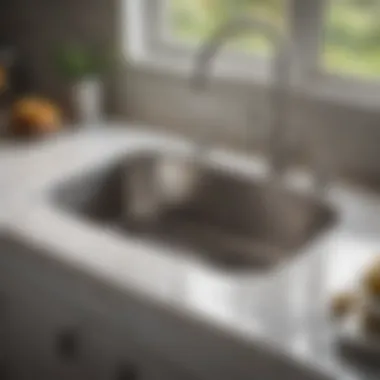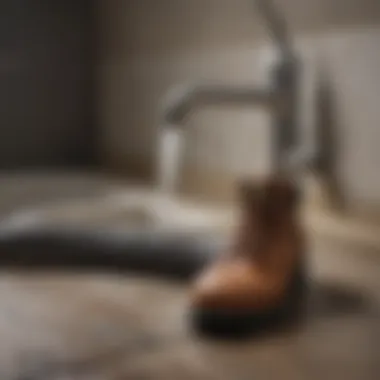Top Solutions to Unclog Your Kitchen Sink: Guide


Intro
A clogged kitchen sink presents frustration for both homeowners and renters alike. It disrupts daily tasks, from washing dishes to preparing food. Understanding how to effectively address this common plumbing problem is crucial. This guide examines products specifically designed to unclog sinks, addresses various techniques, and evaluates both chemical and natural solutions. By doing so, it aims to offer practical insights for maintaining a smoothly functioning kitchen.
Effective Products for Unclogging
When dealing with a clogged kitchen sink, choosing the right product is essential. Effective unclogging products come in several forms, including chemical solutions, natural remedies, and tools.
Chemical Solutions
Chemical clog removers are often the first choice for many homeowners. They typically feature powerful compounds that break down organic material. Here are some notable products:
- Drano Max Gel: A strong gel formula that adheres to clogs, allowing it to work effectively even in standing water.
- Liquid-Plumr: Known for its fast-acting formula, it's a reliable option for dissolving grease and other clog-causing substances.
It's important to follow instructions carefully. Always use gloves and ensure adequate ventilation during application.
Natural Remedies
For those seeking eco-friendly alternatives, there are several natural solutions worth considering:
- Baking Soda and Vinegar: This common household mixture can effectively dislodge smaller clogs. The reaction between the two creates carbon dioxide, helping to loosen debris.
- Salt and Baking Soda: Mixing equal parts and pouring it down the drain can help combat minor clogs.
Natural remedies are often less harmful to plumbing systems and the environment. They also provide an alternative for those wary of chemicals.
Tools for Unclogging
In addition to chemical and natural solutions, having the right tools can make the process easier:
- Plumber's Snake: A flexible auger that can reach deep clogs.
- Plunger: A recognizable tool that can create necessary suction to dislodge stubborn clogs.
Preventive Measures
After successfully unclogging your sink, consider implementing preventive measures to avoid future issues. Regular maintenance is key. Here are a few tips:
- Avoid Pouring Grease Down the Drain: This can solidify and cause significant blockages.
- Use Drain Screens: These can catch food particles and other debris, reducing the chance of clogs.
"Preventive measures reduce the need for chemical solutions and promote a more sustainable household environment."
By taking proactive steps, homeowners can maintain a clean and effective kitchen sink. The products and methods discussed here serve as valuable resources to tackle clogs efficiently.
Prolusion to Kitchen Sink Clogs
Clogged kitchen sinks are a common problem in many households. Understanding this issue is crucial for effective home maintenance. Clogs can occur due to various reasons, impacting the functionality of the sink and resulting in inconvenience. This section will explore the causes of kitchen sink clogs and how they can affect daily life, providing a foundation for selecting the right solutions later in the guide.
Understanding the Causes of Clogs
Kitchen sinks typically become clogged for several reasons. Food debris is among the most frequent culprits. Small particles from cooking and washing dishes can accumulate over time. Grease and oil are also major contributors. These substances can solidify and stick to the pipe walls, narrowing the passage for water. Additionally, foreign objects like utensils or small items can accidentally fall into the sink. Hair and soap residue may collect in drains, contributing further to blockages.
Awareness of these factors can help homeowners take proactive steps to prevent clogs, aiding in the long-term maintenance of their plumbing.
Impact of Clogged Sinks on Daily Life
The impact of a clogged kitchen sink extends beyond mere inconvenience. Daily routines can be disrupted when a sink does not drain properly. This issue can lead to increased stress and frustration, particularly in busy households. Tasks like washing dishes or preparing meals may become complicated.
Moreover, clogs can create an unhealthy environment. Standing water can attract pests and promote the growth of harmful bacteria. Homeowners might also face additional expenses if the clog requires professional plumbing services. This financial burden can sometimes be avoided with maintenance and proper knowledge of unclogging solutions.
In summary, understanding kitchen sink clogs is essential. Identifying causes allows for better prevention strategies and early interventions. This knowledge sets the stage for exploring effective products and methods to tackle clogged sinks throughout this guide.


Overview of Unclogging Products
Clogged kitchen sinks are a common issue that can disrupt daily routines. Understanding the products available for unclogging is essential for effective problem-solving. This section sheds light on different types of unclogging products. It also discusses how selecting the right type can save time and effort in the long run.
Types of Unclogging Products
Unclogging products can be broadly categorized into three main types: chemical drain cleaners, enzyme-based products, and mechanical methods.
Chemical Drain Cleaners
Chemical drain cleaners are among the most widely used solutions for clogged sinks. They contain powerful chemicals, often hydroxides, that effectively break down organic materials, such as grease and food particles. One key characteristic of chemical drain cleaners is their speed; they usually show results within minutes. This makes them popular in emergencies where time is of the essence.
However, these cleaners come with risks. Many chemical drain cleaners can be harsh on pipes, especially older plumbing systems. This can lead to long-term damage. Additionally, their chemical composition can present environmental hazards. Homeowners must carefully consider the brand and formulation they choose. For instance, products like Drano or Liquid-Plumr are effective but require caution.
Enzyme-Based Products
Enzyme-based products offer a more natural approach to unclogging. They utilize enzymes that digest organic waste, making them an attractive option for those seeking an eco-friendly solution. A notable feature of these products is their slow-acting nature, often requiring hours or overnight application for full effectiveness.
The advantage of enzyme-based solutions is their safety for plumbing and the environment. Unlike their chemical counterparts, they do not produce harmful fumes and are less likely to cause pipe damage. Brands such as Bio-Clean are known for their effectiveness, though they might not provide instant results like chemical cleaners.
Mechanical Methods
Mechanical methods involve physical techniques to remove clogs. These include using a plunger, snake, or even a wet/dry vacuum. The key aspect of mechanical methods is that they do not involve chemicals at all, making them safe for all plumbing types.
One notable feature of mechanical unclogging is versatility. For instance, a plunger can address various blockage levels, from minor to severe. The downside is that these methods often require direct physical effort and can be messy. Moreover, they may not succeed in clearing deep clogs or those caused by tree roots. Nevertheless, mechanical methods can be a reliable option when other products fail to deliver the desired results.
Choosing the Right Product
When selecting an unclogging product, consider factors such as the type of clog, urgency, and environmental impact. Evaluating these elements can lead to better outcomes and ultimately a more efficient unclogging experience.
Chemical Drain Cleaners: Benefits and Risks
Chemical drain cleaners are widely used solutions for unclogging kitchen sinks. They can provide quick relief from stubborn clogs, which is essential in maintaining kitchen functionality. However, understanding both the benefits and risks associated with these products is crucial for making informed choices. These cleaners often contain strong chemicals that can dissolve grease, hair, and other materials that contribute to clogs. Still, one must be cautious about their usage due to potential health hazards and environmental impacts.
Mechanism of Action
Chemical drain cleaners usually employ either caustic materials or acids to dislodge blockages in drains. Caustic drain cleaners often contain sodium hydroxide or potassium hydroxide. These substances generate heat upon contact with water, helping to break down organic matter. Acidic drain cleaners, on the other hand, utilize sulfuric acid or hydrochloric acid. Their high acidity can effectively dissolve tough clogs but also poses substantial risk to pipes and the user if misapplied. Understanding how these chemicals work allows users to select the appropriate cleaner based on the nature of the clog.
Environmental and Health Considerations
Using chemical drain cleaners comes with significant environmental and health considerations. Many products contain hazardous substances that can harm both individuals and ecosystems.
- Health Risks: Exposure to chemical drain cleaners can lead to skin irritation, eye damage, and respiratory problems. Ingesting these cleaners can be life-threatening. Therefore, using gloves and eye protection is advisable during application.
- Environmental Effects: Improper disposal of chemical cleaners can contaminate water sources. They can also contribute to pollution when they enter sewage systems and waterways, affecting aquatic life.
For these reasons, it is vital to read labels carefully and follow safety precautions while using these products.
Recommended Brands
When it comes to chemical drain cleaners, some brands have established themselves as reputable due to their effectiveness and commitment to safety. Here are a few worth mentioning:
- Drano: A well-known option in many households, effective for a wide variety of clogs. Drano Max Gel is particularly popular.
- Liquid-Plumr: Offers several formulations, including one designed specifically for hair clogs.
- Zep: Known for its industrial strength, Zep can be useful for more severe clogs but should be used with caution.
Before selecting a brand, consider examining user reviews and ensuring that the product is suitable for your plumbing system and clog type.
Enzyme-Based Solutions: A Natural Approach
Enzyme-based solutions provide a unique alternative to traditional chemical cleaners for unclogging kitchen sinks. Their methodology is inherently biological, relying on natural enzymes that break down organic matter. This section will delve into how enzymes work, their advantages over chemical cleaners, and some recommended brands that stand out in the market.


How Enzymes Work
Enzymes are proteins that accelerate chemical reactions, which makes them highly efficient at tackling clogs. In the context of kitchen sinks, enzymes target organic material such as food particles, grease, and soap scum. When introduced into the drainage system, these enzymes bind to specific substances in clogs, facilitating their decomposition. The process is gradual, often requiring several hours to achieve noticeable results. Thus, patience is key when using these products.
Advantages Over Chemical Cleaners
Choosing enzyme-based solutions presents particular benefits:
- Eco-Friendly: These products are typically less harmful to the environment. Unlike harsh chemical cleaners, they do not release toxic fumes or harmful byproducts.
- Safety for Plumbing: Enzymes are gentle on plumbing systems, reducing the risk of damage often caused by corrosive chemical cleaners.
- Long-Term Efficacy: Regular use of enzyme-based products can help maintain clear pipes over time, as they continually break down organic build-up, preventing the formation of clogs.
- Non-Toxic: They are safer for homes with children and pets, minimizing health risks associated with strong chemical cleaners.
Given these advantages, many homeowners are turning to enzyme-based solutions as a practical, long-lasting alternative in maintaining a healthy plumbing system.
Recommended Brands
When selecting enzymatic cleaners, it is essential to consider quality and effectiveness. A few notable brands in this category include:
- Bio-Clean: This product combines natural enzymes and bacteria, making it effective in both clearing clogs and maintaining a clean drain.
- Green Gobbler: Their enzyme drain cleaner works efficiently to dissolve organic material without harmful chemicals.
- Earth Enzymes: Known for their environmentally friendly formulation, Earth Enzymes provide a safe choice for those prioritizing sustainability.
Each of these brands prioritizes effectiveness while ensuring safety for both users and the environment. Implementing enzyme-based solutions not only addresses immediate clog concerns but also supports ongoing plumbing health.
Mechanical Methods for Unclogging
Mechanical methods are essential in effectively addressing kitchen sink clogs. They offer a practical, hands-on approach that can often resolve clogs without the use of chemicals. These methods are important because they directly target the blockage in a physical manner. Homeowners often prefer mechanical methods due to their immediate effectiveness and the minimal risk of damaging plumbing systems.
When choosing to unclog a drain mechanically, it is crucial to understand the tools available. Each method has its strengths and specific considerations to keep in mind. The benefits include not needing chemical agents, which can be harmful to both health and environment. Also, mechanical methods often yield immediate results.
Despite these advantages, it is vital to approach mechanical unclogging with care. Improper use can lead to further damage, such as pipe punctures or additional blockages. Here, we explore three common mechanical techniques for unclogging a kitchen sink: using a plunger, snaking the drain, and the wet/dry vacuum technique.
Using a Plunger
A plunger is one of the simplest and most effective tools for clearing a clogged kitchen sink. To use it, ensure there is sufficient water in the sink to cover the rubber bellows of the plunger. Place the plunger over the drain and apply steady pressure to create suction. Push downwards firmly, then pull up quickly to break the clog. Repeat this motion several times, as it may take multiple attempts to clear the blockage completely.
Plungers are particularly effective for food remnants and small objects that may be stuck in the drain. However, they may not work well for more challenging clogs, such as those caused by grease or soap buildup.
Snaking the Drain
A drain snake, or plumbing auger, is a useful tool for tougher clogs that plungers cannot resolve. It consists of a flexible metal coil that can reach deeper into pipes. To use, insert the end of the snake into the drain and turn the handle. This will help the snake navigate through bends in the pipes to reach the blockage. Continuing to rotate and push allows the snake to either break up the clog or latch onto it for removal.
This method can be effective for clogs caused by hair, grease, or accumulated debris further down the drain. However, users should exercise caution to avoid damaging the pipes; excessive force may cause harm.
Wet/Dry Vacuum Technique
Using a wet/dry vacuum can be an efficient method for clearing clogs, especially when it involves large amounts of water or solid debris. First, set the vacuum to the liquid setting. Then, create a seal around the drain with the vacuum hose, ensuring it captures as much water and debris as possible. Turn on the vacuum, which will draw the clog into the tank.
This technique is excellent for removing large materials or considerable amounts of water. However, it can be more complex to set up and may not always reach clogs located deep within pipes.
Overall, mechanical methods provide valuable solutions for unclogging a kitchen sink. Homeowners should consider the type of clog and the right tools to use, ensuring effective and efficient unclogging.
Comparison of Unclogging Methods
Understanding the various methods for unclogging a kitchen sink is essential for homeowners and DIY enthusiasts alike. Each approach possesses unique characteristics and effectiveness, which can affect the decision-making process when faced with a clogged sink. The ability to compare these methods in terms of effectiveness, time investment, and cost allows for informed choices that can save both time and money. This section explores these critical elements in detail.
Effectiveness of Various Products
The effectiveness of unclogging products often varies significantly. Chemical drain cleaners, while quick to use, may not always resolve severe blockages. They work by breaking down organic materials, but their potency depends on the type of clog. On the other hand, enzyme-based solutions can be slower but tend to be safer for plumbing and the environment.
Mechanical methods, such as using a plunger or a drain snake, often provide immediate relief for many clogs, but they require some manual effort and skill. Understanding what each method can achieve is vital in selecting the right approach.


Time Investment for Solutions
Time is an important consideration when selecting an unclogging method. Chemical solutions typically act within minutes, allowing the user to resume normal sink function quickly. However, their effectiveness might not last, leading to repeated applications. Enzyme-based cleaners typically require patience, as they may take hours or even days to work effectively.
Manual methods vary; using a plunger can take only a few minutes, while snaking a drain requires a bit more time and technique. For those who prefer not to spend much time on this task, quick-acting products may seem appealing. However, long-term effectiveness should also be part of the time investment equation.
Cost Analysis of Approaches
Cost is another significant factor in evaluating unclogging methods. Chemical drain cleaners are often inexpensive per bottle but can lead to higher long-term costs due to frequent use if they are ineffective. Enzyme-based products generally have a higher initial cost but provide lasting benefits without damaging plumbing.
Mechanical solutions such as plungers and drain snakes often represent a one-time investment, reducing the need for repeated purchases. Additionally, these tools can be reused for various future clogs, making them cost-effective in the long run. Evaluating the initial cost against potential re-use can help in making a final decision about which method to employ.
Consider not only the immediate cost of unclogging methods but also their long-term effects on your plumbing and wallet.
When comparing these unclogging methods, it becomes clear that several factors guide the best choice for individual situations. Effectiveness, time investment, and cost each play a role in the decision. By weighing these elements, homeowners can select the most appropriate product or method for addressing their kitchen sink clogs.
Implementing Preventive Measures
Implementing preventive measures is essential for maintaining a properly functioning kitchen sink. By taking proactive steps, homeowners can reduce the likelihood of clogs and prolong the lifespan of their plumbing system. Preventive measures not only save time and money but also enhance the overall health of the home environment. Regular attention to sink usage can significantly lower the risk of future problems.
Regular Maintenance Tips
Adopting regular maintenance practices is crucial to keeping your kitchen sink in good working order. Here are some effective tips:
- Run hot water after each use. This helps dissolve any grease or food particles that may have accumulated.
- Use a sink strainer to catch larger particles and prevent them from entering the drain.
- Flush the drain weekly with a mixture of baking soda and vinegar. This natural remedy can break down build-up and keep the drain fresh.
- Inspect the trap under the sink regularly. Ensuring it is not blocked can prevent backups or unpleasant odors.
These routine habits ensure that small problems are addressed before they escalate into major clogs.
What to Avoid Putting Down the Sink
One of the most significant contributors to clogged kitchen sinks is improper disposal of substances. To maintain a clear drain, avoid the following:
- Grease and fat: These can solidify and attach to pipe walls, leading to serious clogs.
- Coffee grounds: Even small amounts can accumulate and form blockages.
- Starchy foods: Items like rice or pasta expand when wet, creating potential for backup.
- Fibrous vegetables: Peelings from items like celery or potatoes can tangle and obstruct the flow.
"Avoiding these common items when maintaining a kitchen sink can significantly reduce the risks of clogs and the need for cumbersome repairs."
By being mindful of what goes down the sink and adhering to regular maintenance strategies, homeowners can ensure that their kitchen sink stays functional and efficient. This proactive mindset fosters an environment free from the hassle of frequent and annoying clogs.
Finale
Understanding how to effectively deal with a clogged kitchen sink is pivotal for maintaining a functional home. A clogged sink can disrupt daily activities and lead to various inconveniences. This article provided an extensive exploration of several unclogging methods, evaluating the strengths and weaknesses of chemical drain cleaners, enzyme-based products, and mechanical techniques. Each approach offers distinct advantages, depending on the situation and personal preferences.
Summarizing Key Points
To summarize, it is crucial to remember that each type of product serves particular needs. Chemical drain cleaners are fast-acting but come with environmental risks. Enzyme-based solutions are safer for the environment and can be effective in prevention. On the other hand, mechanical methods remain reliable for immediate physical blockages. Additionally, assessing factors such as effectiveness, time investment, and costs is essential in choosing the right method for unclogging.
"Preventive measures are not just suggestions; they are essential behaviors for every homeowner to avoid future clogs."
Final Recommendations
For those experiencing persistent issues with kitchen sink clogs, a combination of approaches might yield the best results. Start with preventive measures, such as regular maintenance and being mindful of what goes down the sink. If a clog does occur, consider using an enzyme-based product for regular cleaning, supplemented by mechanical methods when necessary. When selecting components like chemical drain cleaners, evaluate risks and choose brands that are less harmful. By adopting a comprehensive strategy, you can effectively manage clogs and ensure smooth operational flow in your kitchen.
Links to Product Guides
Product guides are an essential element for anyone dealing with clogged sinks. These guides can include everything from detailed reviews of specific brands like Drano and Bio-Clean to comparison charts that help users discern the right choice for their situation.
- Drain Cleaners: Information on chemical vs. natural options, including user experiences and formulations.
- Plungers: Different types and their specific advantages, ensuring that users choose the right model for their needs.
- Snakes: Guidance on the use of drain snakes, including length and flexibility considerations to effectively clear out debris.
Each product guide enables the reader to delve deeper into the features and benefits of various unclogging tools. Furthermore, understanding how to use each product correctly can significantly enhance its efficacy.
Further Reading on Home Maintenance
Further reading adds an extra layer of knowledge for those looking to enhance their home maintenance skills. This can include materials on broader home maintenance topics that could prevent future clogs.
- Preventive Maintenance: Guidance on regular checks and maintenance routines that can help keep the kitchen sink functioning well.
- Waste Disposal Practices: Information about what should and shouldn’t go down the sink, which is vital in preventing clogs.
- General Home Improvement: Articles and resources that provide tips for better living environments, thus ensuring a cleaner and happier home.
Overall, this section not only opens up avenues for further learning but also encourages responsible and informed home maintenance practices. By linking to reputable sources and guides, readers can harness the knowledge required to keep their kitchens in excellent working condition.















